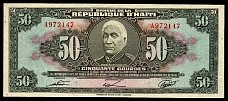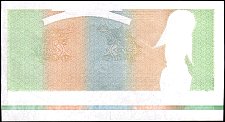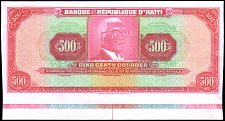|
||||
|
||||
|
|||||||||||||||||||||||||||||||||||||
|
Sig. T No Prefix, D, E |
|||||||||||||||||||||||||||||||||||||
|
|
|||||||||||||||||||||||||||||||||||||
|
Sig. T No Prefix and Prefix A-E |
|||||||||||||||||||||||||||||||||||||
|
|
|||||||||||||||||||||||||||||||||||||
|
Sig. T Prefix A - T
, AA - AP |
|||||||||||||||||||||||||||||||||||||
|
Sig.
U |
|||||||||||||||||||||||||||||||||||||
 N.1088, P.235a 50 Gourdes |
50
Gourdes 2 Signature Varieties |
Sig. T Prefix A, B, G Issued 1980 - 82 |
|||||||||||||||||||||||||||||||||||
|
TYVEK Issued 1980 - 82 |
|||||||||||||||||||||||||||||||||||||
|
TYVEK Issued 1982 - 83 |
|||||||||||||||||||||||||||||||||||||
 N.1090, P.236a 100 Gourdes |
100
Gourdes 2 Signature Varieties |
Sig. T:
Prefix A, B Issued 1980 - 82 |
|||||||||||||||||||||||||||||||||||
|
TYVEK Issued 1982 - 83 |
|||||||||||||||||||||||||||||||||||||
 |
250 Gourdes |
PROGRESSIVE PROOFS |
|||||||||||||||||||||||||||||||||||
 |
500 Gourdes |
PROGRESSIVE PROOFS AND ARCHIVE BOOKLET |
|||||||||||||||||||||||||||||||||||
 N.1094, P.238a 500 Gourdes |
500
Gourdes 1 SIgnature Variety |
TYVEK Issued 1982 - 1983 |
|||||||||||||||||||||||||||||||||||
|
|
|||||||||||||||||||||||||||||||||||||
As can be seen, a sizeable number of notes were printed on Tyvek, and the notes were quite commonplace in general circulation. The 50 gourdes (which comes in two different signature/watermark varieties) was the first to be introduced into circulation, while the other denominations followed shortly thereafter. Paper versions of the same design circulated alongside the Tyvek notes for the four lowest denominations, but it can be presumed that whenever they were withdrawn the Tyvek issues were set aside to see how they had held up in circulation. The Tyvek series was printed by the American Banknote Company (commonly abbreviated as ABNC) in New York, the famous printing company that had printed banknotes for Haiti for many years. Even though the designs were identical to those of earlier issues, new printing plates were made for each of the denominations, with minute differences. The printing plate of the Tyvek 100 gourdes, for example, was just a hair bigger than the printing plate for the paper 100 gourdes already in circulation, although the difference can been seen only when the two notes are compared side by side. Tyvek notes are generally pretty easy to identify, as the paper is noticeably different. They also have unique prefixes in the serial number, and, unlike the paper issues, they do not have colored planchettes (small dots) added to the paper. Even though the entire series of banknotes from Haiti makes for an interesting study (and rarities, as even notes from the 1960s and 1970s are often very difficult to find in any grade) it is the Tyvek series that is the most popular with collectors. As they’re the first banknotes in a medium that sees more and more use in recent years (even though in slightly different substrates), collectors have started to take notice, and values for Uncirculated pieces have started to increase rapidly. From personal experience, the rarity of the series goes up with each denomination, except that the 2 gourdes is a little more readily available than the 1 gourde. The 50 and 100 gourdes are very scarce but appear on the market multiple times each year, while both the 250 gourdes and 500 gourdes are major rarities that are very rarely offered for sale. The last Uncirculated examples of the two highest denominations to appear at public auction were sold in 2009, when the 250 gourdes brought $3,900, while the 500 gourdes brought $4,887.50. It is believed that if such a pair were offered at auction today, these two notes combined could easily bring five figures.
For collectors wishing to add some Tyvek notes from Haiti to their
collections, the two lowest denominations are not only easier to find,
they are also a lot more affordable, even though the low values in the
Pick catalog are of no use. For the 1 gourde in Gem Uncirculated
condition, a collector should expect to pay $100–$125, while a 2 gourdes
in the same condition brings about $80–$100 at the time of writing
(April 2017). The 50 gourdes is a lot scarcer and sells for about
$600–$800, while the 100 gourdes is easily a $1,000+ banknote in Gem
Uncirculated condition and is very difficult to find. Specimens and
Proofs of all denominations are sometimes seen but are quite scarce; but
for the 250 gourdes and 500 gourdes they are generally all that is
available to collectors. Because of this they sell readily for around
$1,000. The 2 gourdes also exists with a red overprint that crossed out
the portrait of Duvalier and “7 Fev. 1986” (the date of the Haitian
revolution that led to the overthrow of Duvalier’s son, Jean-Claude
Duvalier). The origin of these is unclear, and they are generally
considered private fabrications made after the Tyvek pieces circulated. |
|||||||||||||||||||||||||||||||||||||
|
Dupont
TYVEK was used by the American Bank Note Company (ABNC) to produce some Haïti banknotes for a limited period during 1980-83. TYVEK
is used extensively as a building material and in auto racing.
|
(1) Printer information provided by
Champion Stamp Company
Tyvek® is a registered trademark of
E.I. du Pont de Nemours
and Company
| Printer: |
American Banknote Company (ABNC) |
| Signatures: |
T;
Gerard Martineau, Raoul Berret, Rene Lafontant |
| Size: |
1,
2 Gourde; 122 x 62mm; |
![]()